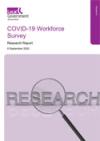This is report is part of a series of bi-weekly surveys of all councils in England, Wales and Northern Ireland collecting key workforce data on how the sector is responding to COVID-19.
An online survey is emailed to heads of human resources, or a nominated contact, in councils from England, Wales and Northern Ireland on alternate Wednesdays. The data requested relates to the week ending the preceding Friday. The intention is that this collection is the single national source through which such data is gathered, and it will, as appropriate, be shared with government departments and others in addition to providing comparator information for councils.
This report relates to the survey sent out on 23 September 2020. The overall response rate was 56 per cent and covered over a third of the total workforce.
Key findings
- Some 33 per cent of councils reported recruiting additional staff (of any type including casual, agency, contingent, etc) in the week ending 18 September 2020. In total 1,115 additional staff had been recruited in responding authorities: the median number of staff per authority was three and the mean was 19.
- More than a third of councils (120) recorded deaths in service since lockdown. A total of 298 deaths in service were reported by respondents since the start of lockdown (cause not specified).
- Twenty per cent of councils reported that they had fully furloughed at least one member of staff. In total, responding authorities reported there were 3,820 staff furloughed full-time in the week ending 18 September 2020, which was 0.7 per cent of the current workforce.
- In addition, 22 per cent of councils reported that they had partially furloughed at least one member of staff. In total, respondents reported there were 2,457 staff furloughed part-time in the week ending 18 September 2020, which was 0.5 per cent of the current workforce.
- The main reason given for furloughing staff was that the service had stopped (85 per cent) or that funding had stopped (35 per cent).
- Some 54 per cent of councils had redeployed staff. In total, in the responding authorities there were 5,499 staff redeployed in the week ending 18 September 2020, which was one per cent of the current workforce. The median number of staff redeployed was 2 and the mean was 30.
- Just over eight out of ten councils (83 per cent) reported that they had at least one member of staff unavailable for work. In total, respondents reported there were 25,252 staff unavailable for work in the week ending 18 September 2020, five per cent of the current workforce. The median number of staff unavailable for work was 35 and the mean was 127.
- Fourteen per cent of staff were unavailable through ‘self-isolation (other)’ and 52 per cent were unavailable due to ‘non-COVID sickness’.
- When asked whether individual services had enough staff to run them normally or not, the service most badly affected during the week ending 18 September was schools: 31 per cent of councils reported they were operating with moderate or severe disruption due to staffing numbers. Also badly affected were adults and children’s services, with 24 per cent and 21 per cent of councils respectively reporting moderate or severe disruption.
- When asked to assess the council overall, in terms of whether there are enough staff to run services normally or not, 55 per cent of councils report minor or moderate disruption and 45 per cent were operating normally.
- Councils that had gone through a local lockdown in the week ending 18 September (there were 24) were asked about the availability of personal protective equipment (PPE) and COVID-19 testing for staff. Ninety-two per cent reported they had about the right amount of PPE they needed; whilst four per cent had less than they needed. Fifty per cent said all the staff who need testing can access it, whilst four per cent said none of the staff that need testing can access it.
- Looking ahead, councils were asked if they were experiencing significant difficulties recruiting for some posts or not: 74 (35 per cent) said they were. Councils were subsequently asked to choose from a list of specialist occupations where they were experiencing difficulties: 50 per cent of councils were having difficulties recruiting children’s social workers, 36 per cent were having difficulties recruiting planning officers and 35 per cent were having difficulties recruiting environmental health officers.
- Councils were asked to choose the five occupations or roles where recruitment difficulties were most acute. Fifty-two per cent of the 71 councils who answered the question had acute difficulties recruiting children’s social workers.
- Out of the thirty-six councils who had said they had acute difficulties in recruiting children’s social workers, 44 per cent said they had both difficulty recruiting generally and difficulty recruiting the required expertise, experience or qualification.
To view an accessible version of this document, please email [email protected].

- Published by:
-
LGA
- Reference code:
